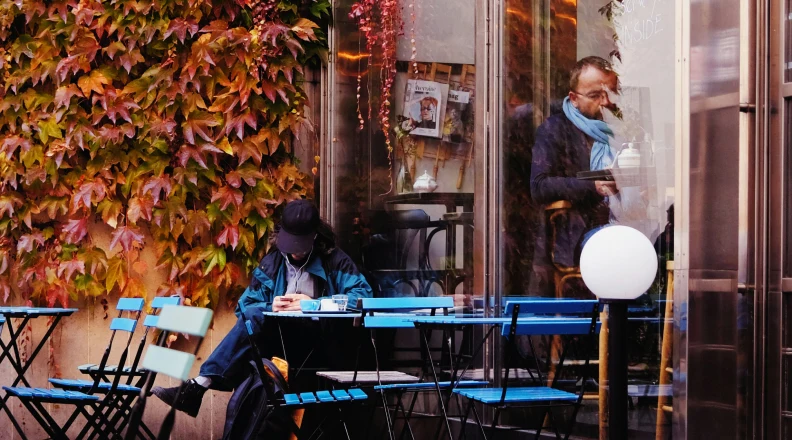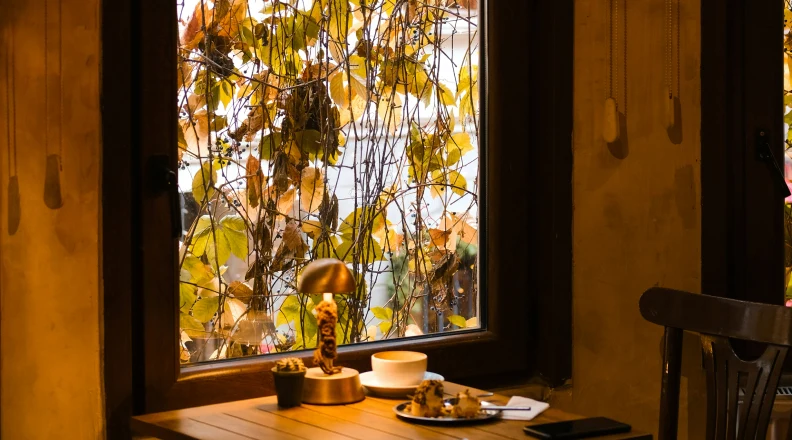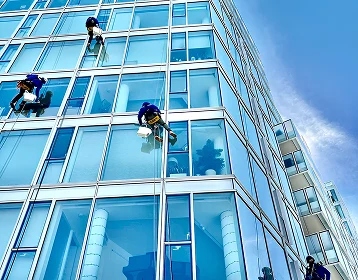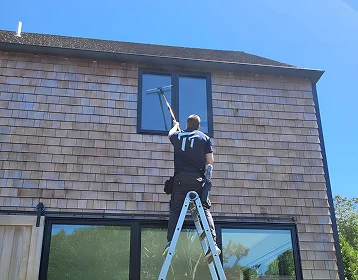Fall in New York shifts the rhythm of the streets and covers the neighborhoods in warm colors. This is the time when local coffee shops step into the spotlight of the cityscape. Their corner windows and wide glass fronts become natural focal points, drawing the eyes of passersby who pause to look inside, snap a picture, or simply take in the feeling of comfort that defines the season.
Corner cafés carry a special role in shaping the character of a block. On one level, they host the daily ritual of morning coffee on the way to work or an evening chat with friends. On another, the windows themselves become storytellers. Clean glass highlights the play of light, reflects leaves and streetlights, and makes the café a visible part of the changing fall landscape.
New York neighborhoods transform with the seasons, and fall is especially celebrated. Seasonal changes, such as falling leaves, are noted by NYC Parks as a time when local streets and parks become particularly inviting for outdoor walks. For small coffee shops this means that windows and facades are connections between what happens inside and the atmosphere outside.
Glass that shapes the feeling of a street
The way glass interacts with its surroundings defines the atmosphere of a café. Reflections of passing cars, trees turning gold, and small seasonal decorations all play across the surface. Clean windows allow the warm glow of lamps and displays to stand out, while smudged or foggy ones can hide these details and reduce their effect. In fall, when people walk slower and pay more attention to what is around them, the role of clear glass is even more visible.
For city architecture, glass frames views, it lets buildings interact with light and it creates facades that feel open rather than closed. A coffee shop on a corner with wide windows becomes part of the street’s identity. ArchDaily highlights that the use of transparent facades can enhance the sense of openness and character in modern urban architecture.
In the context of neighborhood life, this means glass is never neutral. A well-kept window can showcase a row of pumpkins on a counter or the sight of steam rising from fresh cups. A neglected one can make the same scene look muted. People notice these details, even unconsciously, and they shape the perception of comfort, warmth, and quality. Clean glass, therefore, becomes part of how fall streets look and how locals and visitors experience the small rituals of the season.
What the season leaves on the glass
Fall changes the look of café windows in ways that are often less visible at first, but have a strong impact over time. Corners that feel warm and inviting can quickly lose their clarity when moisture, dust, and leaves settle on the glass. The problem is not only aesthetic, it affects how customers perceive the atmosphere of a place. Windows that no longer look transparent can make the interior feel darker and less open, which is the opposite of what people expect from their favorite coffee spot in the cozy season.

Several factors influence how fast glass loses its clarity:
- Moisture and condensation. As temperatures shift during the day, café windows fog up from inside and outside. This constant cycle of condensation makes the glass appear cloudy and encourages small marks that are hard to remove without proper cleaning.
- Falling leaves and organic matter. Leaves that gather on window ledges or stick to damp surfaces leave behind stains and natural residue. These traces do not go away with a simple wipe and often require chemical or professional cleaning methods.
- Street dust and traffic pollution. Busy corners carry particles from cars, construction, and general street activity. Dust settles faster in fall, because damp conditions make it cling to the surface. The EPA emphasizes that particulate matter in urban air can accumulate on exterior surfaces, affecting both appearance and maintenance needs.
- Bacterial and fungal growth. Where moisture and organic residue remain, microorganisms find an easy environment to spread. This process is slow, but steady, and it affects both cleanliness and hygiene standards for any establishment that relies on customer trust.
The combination of these factors shows how quickly the look of glass can change in a single season. A window that was clear in early September may already seem dull by October if it is not maintained. For cafés that depend on atmosphere and visual appeal, this is a real risk to their reputation as well as to compliance with city health and sanitation expectations.
When daily work meets seasonal reality
The weather, customer flow, and day-to-day routines shape how well storefront windows are maintained, and many owners discover that keeping the glass clear is more complicated than it looks. What seems like a simple cleaning task can turn into a consistent challenge once the season brings rain, wind, and early darkness. Small streaks and foggy patches on glass accumulate, gradually diminishing the warm, inviting appearance that draws customers inside.

The main difficulties usually include:
- Unpredictable weather. Rain, wind, and occasional frost make any recent cleaning effort short-lived. Glass can be spotless in the morning, but covered with streaks and marks by the afternoon, and this cycle repeats itself during most of the season. Even light drizzle leaves tiny water spots that mix with dust and pollen, creating visible smudges that are hard to remove without proper tools or solutions.
- Busy staff schedules. Employees in small cafés are often focused on service, preparation, and customer needs. Window maintenance rarely fits into the daily routine, and as a result it is postponed or done in a rush. Quick wiping with whatever is at hand may temporarily improve the appearance, but it rarely removes all marks and often leaves streaks behind, reducing the visual appeal of displays and corner windows.
- Limited resources. Independent coffee shops and local businesses operate on tight budgets, which means they cannot always invest in specialized equipment or frequent professional help. Ladders, squeegees, or eco-friendly cleaning solutions may be too costly for daily use. As a result, glass remains part of the daily atmosphere, but does not receive the consistent care that ensures it reflects light, décor, and seasonal window displays to their fullest effect.
- Street exposure. Corner locations attract attention, but also collect more dirt from vehicles, passers-by, and seasonal debris. Leaves carried by wind often stick to vertical surfaces, while dust and traffic residue cling to glass and frames. These surfaces may lose transparency quickly, and what was once a bright and cozy corner can start to look dull or neglected if cleaning is infrequent.
- Balancing priorities. Owners must weigh the cost of regular maintenance against other needs such as marketing, seasonal décor, or staff hours. The U.S. Small Business Administration points out that small business owners must constantly balance resources, which often includes considerations for the upkeep of storefronts. Even businesses that value presentation may delay cleaning, because customer service and operations take precedence, which can slowly affect the overall impression the café makes on the neighborhood.
Each of these challenges explains why clean windows are not guaranteed even in cafés that take pride in their atmosphere. The effort required goes beyond a quick wipe, and without a clear plan, dedicated attention, or professional support, glass surfaces gradually lose the transparency and warmth that define the cozy appeal of a corner coffee shop in fall.
Keeping corners bright during fall

As fall sets in, corner cafés face a seasonal challenge that goes beyond cozy décor. Leaves, rain, and dust quickly obscure windows and facades, dulling the inviting glow that draws customers. Maintaining a clear and welcoming appearance requires a combination of careful routine cleaning and targeted interventions to address stubborn marks and seasonal debris. Top Team window cleaning helps ensure that windows stay bright and facades retain their charm throughout fall.
Regular cleaning removes light dirt, smudges, and fingerprints, keeping glass clear so interior lighting and fall displays shine through. For areas where rain, mineral deposits, or urban dust leave lasting stains, professional chemical cleaning restores clarity and protects glass surfaces from long-term damage. This approach is particularly valuable for cafés in busy neighborhoods where high foot traffic increases exposure to dirt and moisture.
Pressure washing refreshes outdoor surfaces beyond the glass itself. Facades, sidewalks, and entrance areas collect grime that can affect the overall impression of a café. Using professional pressure washing, accumulated dirt is removed efficiently, leaving the exterior looking bright and welcoming.
24/7 emergency service provides immediate response to unexpected messes. Storms, spills, or other incidents can leave windows and entrances compromised. Rapid cleanup prevents small issues from escalating, ensuring the café maintains a safe and inviting environment for customers even during the busiest fall days.

Fall is a time for cozy corners, warm drinks, and vibrant neighborhood streets, and the appearance of a café plays a key role in the experience. By planning ahead and arranging seasonal service, café owners can ensure that their windows and facades remain bright and inviting throughout fall. Professional cleaning protects the investment in the property, preserves the clarity of glass, and keeps entrances safe and welcoming for customers. Seasonal maintenance also allows staff to focus on running the café smoothly without worrying about gradual wear, stubborn stains, or unexpected debris.
Take the next step and book a free consultation with Top Team window cleaning to get seasonal service that preserves the charm and transparency of your café windows this fall.



